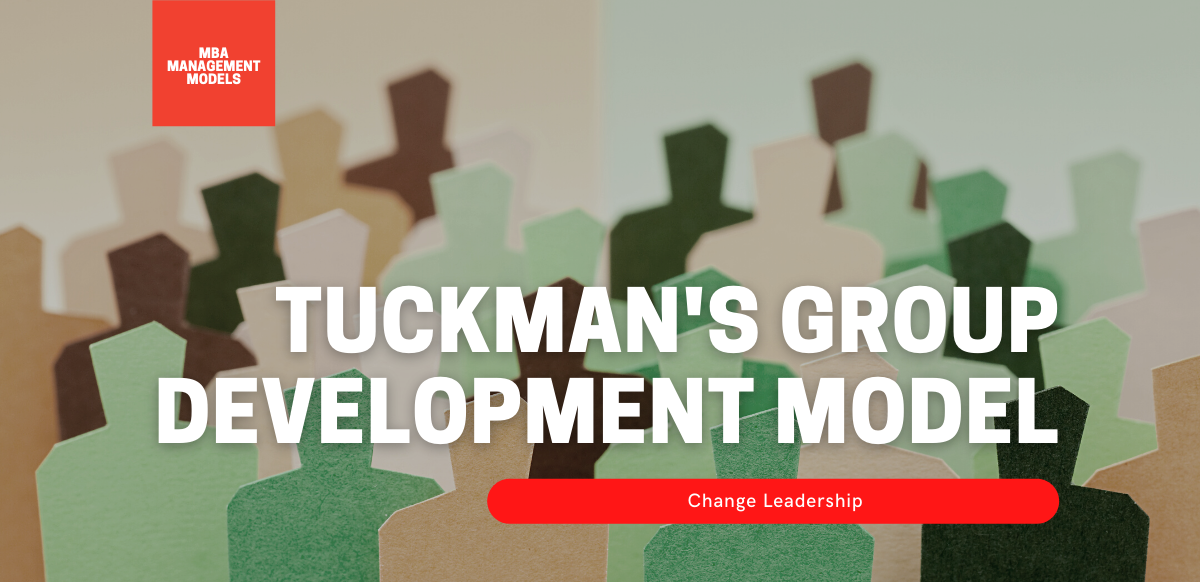Tuckman's Group Development Model
Tuckman's research into team development led him to one of the most widely quoted models of team change. His premise that all teams during their development will experience the stages of forming, storming, norming, performing and adjourning is regularly used in team building within organisations.

What it is
Tuckman's group development model describes a linear process that all teams will encounter when they are first formed and are working towards effective team functioning. The model describes five stages: forming, storming, norming, performing and adjourning.

Teams may also experience this change process when their structure or environment is materially changed. Examples include:
- new team formation
- a new member joining
- a key member leaving
- an increase in delivery pressure
- a change of scope
- an impactful change in the organisational environment
Background
In 1965, the Psychological Bulletin published an article by Bruce W. Tuckman entitled "Developmental Sequence in Small Groups" (see Further reading). In this article, Tuckman described his research into fifty different studies of stages of group development over time. Towards the end of the article, Tuckman proposed a four-stage model of group development, to which he added a fifth stage twelve years later. The model is still used widely within organisations and has been the foundation of much subsequent research.
When to use it
- To identify critical stages in the development of a newly formed team
- To forecast the impact of material changes on a team
- To recognise the state of team maturity and devise strategies to manage and cooperate with groups at different stages
How to use it
The following five sections describe the main characteristics of each stage and suggest some strategies for successful management interaction:
Stage 1: Forming
The Forming stage is characterised by the establishment of dependent personal relationships between team members, leaders and pre-existing standards. During this stage, a set of fundamental questions must be answered by the team:
- What is the primary purpose of the team?
- How should the team be structured to achieve that purpose?
- What roles do team members have?
- Who is the team leader?
- How will individuals relate and work together?
- What are the boundaries of the team?
This stage may be relatively short and painless, particularly within smaller groups, but a lot depends on team members' individual characteristics and motivations. Team agreements related to the questions listed above may be superficial and unobjectionable at this stage.
At this point, team members are likely to be eager and motivated, although there may be some anxiety and questioning related to the change and their role within it. There is usually a polite tone within the group, but the group must be ready to discuss more difficult and controversial topics and become comfortable with conflict if they are to move to the next stage.
The manager of a team during the Forming stage should be highly visible and ready to take the lead. The manager's role here is to facilitate introductions, provide context, set clear expectations and identify success metrics.
Stage 2: Storming
At the Storming stage, the team has settled, and individuals or sub-groups are beginning to rethink and challenge the answers given to the questions asked in the Forming stage and testing assumptions. There is likely some conflict and polarisation around interpersonal issues which must be resolved before the group can progress. This is the stage at which team leaders and managers are most likely to need to deal with some resistance to change.
Although sometimes challenging, this is a natural, healthy and vital stage of team formation. With these issues resolved, the team will have a common understanding of roles, purpose and ways of working.
Managers should encourage feedback and work to resolve issues and build team trust.
Stage 3: Norming
With the team issues resolved during the previous phase, groups within the Norming stage understand their roles and purpose and are working to develop and strengthen team cohesion. Any resistance has been overcome by this stage, individual anxiety levels will be lower, and team members will be engaged, committed and unafraid to express personal opinions. As the work continues, new standards will begin to evolve, and further roles will be identified and adopted.
Sometimes a team may move back and forth continuously between the Storming and Norming stages, which indicates that some issues within the group are not being surfaced and resolved.
Managers of Norming teams should adopt a coaching style and continue to provide opportunities for learning and feedback. Individual and team efforts should be recognised, and energy levels should be monitored to avoid burnout.
Stage 4: Performing
At the Performing stage, any structural issues have been resolved, and team members may adopt a more cross-functional role. All the group's energy is channelled into the task at hand, and individual and team needs can be dealt with simultaneously. This stage sees the team perform consistently and at the highest level.
The team by now requires minimal intervention and demonstrates high levels of collective decision-making and problem-solving. Managers should be sure to continue celebrating successes with the team and strive to prevent unnecessary disruptive environmental changes that may cause the team to return to an earlier stage, thereby reducing performance.
Stage 5: Adjourning
At some point, perhaps at the completion of a task, the team may shrink significantly or break up entirely. Either way, this is such a significant occurrence that it effectively signals the end of the team in its current state.
Managers should ensure that all lessons learned by the team are captured and shared, and any "handover" work and documentation is complete.
This stage sees relationships end, and team members will experience a range of emotions, some of which may need management and support. Individual and team accomplishments should be celebrated.
Frequently asked questions (FAQs)
How does Tuckman's model apply to change management?
As mentioned previously, material changes in the team structure or working environment may cause a team to return to an earlier stage of development. This is important to recognise for managers who are considering the introduction of such a change.
Further reading
Tuckman, B. W. (1965) Developmental Sequence in Small Groups. Psychological Bulletin, 63(6) 384-399.
Some of the links to products provided in this article are affiliate links. This means that the supplier may pay the owner of this website a small amount of money for purchases made via the link. This will have absolutely no impact on the amount you pay.

